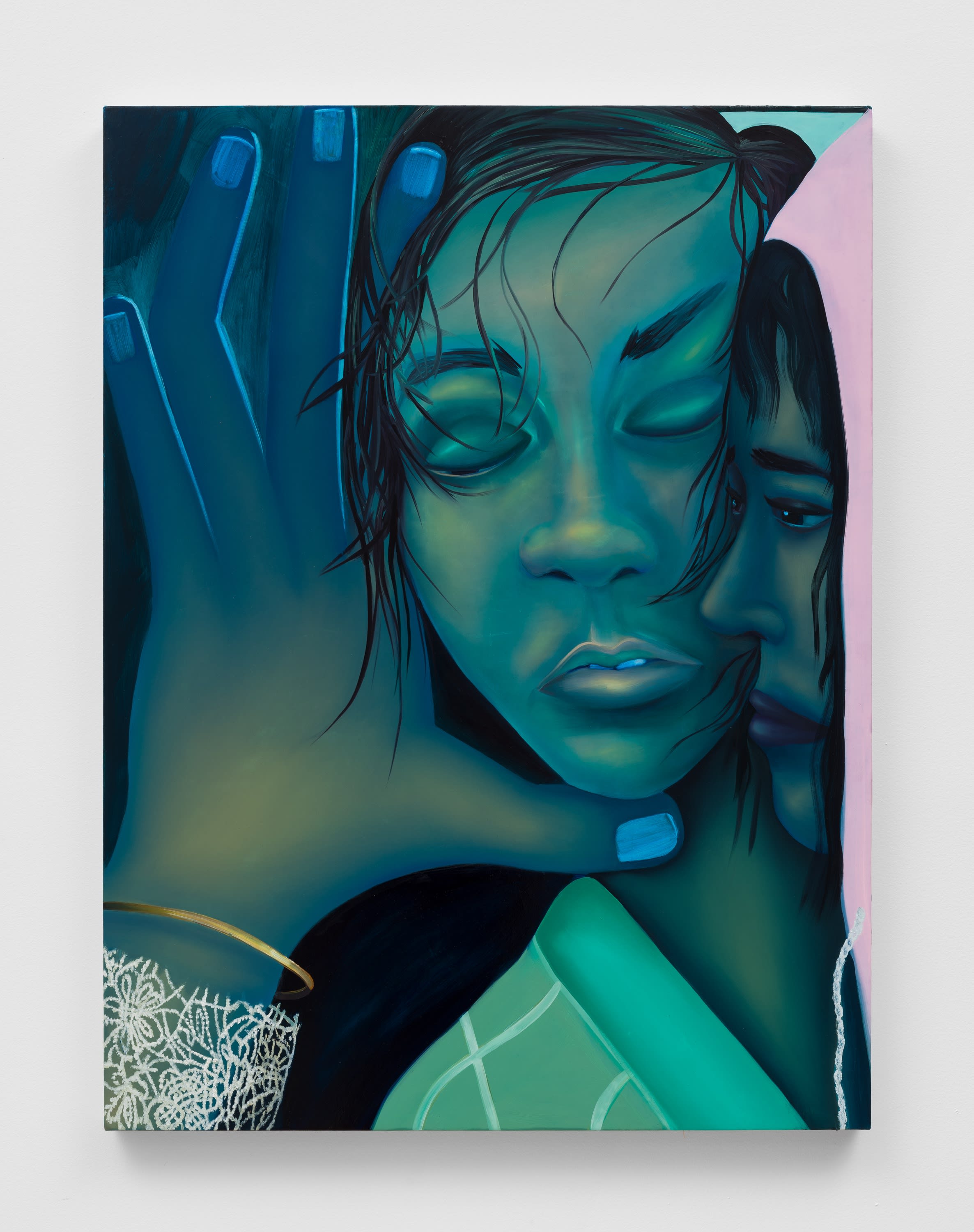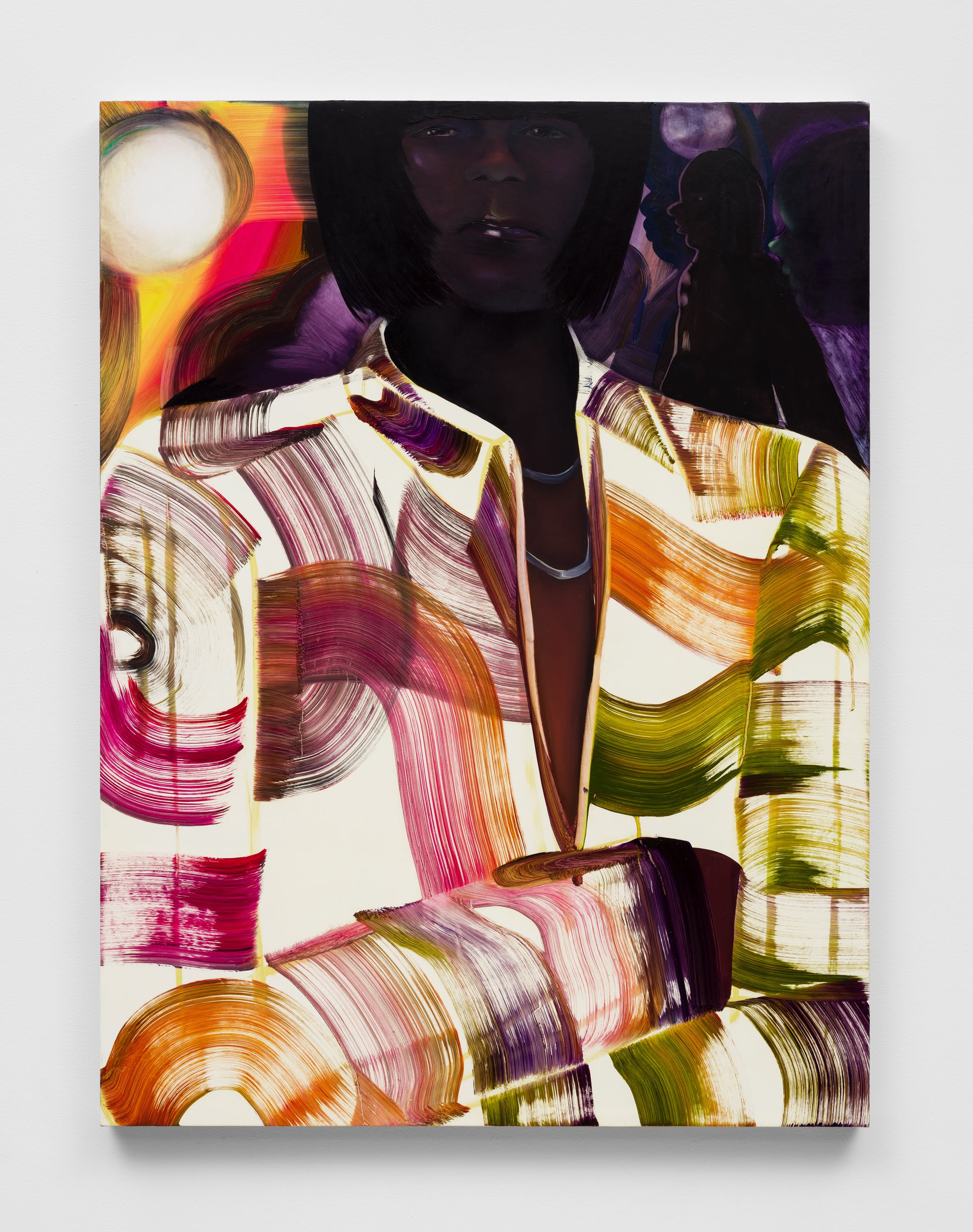
For my own delight and satisfaction, I will take this opportunity to interpret Coady Brown’s nightlife setting in Only In the Darkness Can You See The Stars at Shulamit Nazarian within the imagination of the disco era. “Oldies” are a staple in my life. In fact, in a dream alternate reality, I spend my time DJing decade parties from the late 60s to the early 2000s with a sweet spot in disco-funk world. I love disco music because it’s about giving in to the rhythm, feeling, and reveling in the full and sacred sweat of being who you are. It’s sexy to express yourself in disco. It’s a fever, and it’s designed to possess you. It is a plea to “boogie oogie oogie ‘til you just can’t boogie no more.” To twirl, shake, and thrust to a point of exasperation. And the darkness of a disco, or the low-light, is an invitation to let hidden parts of you come out to play. Disco satiates the thirst to unfurl.
The disco backdrop in Brown’s paintings reminds us of the intimacy of communal sites of pleasure. It may seem foreign now, after nearly two years of a global pandemic, but there was a time when we would pack a room together, each with our own wildly different and rich internal experiences, casually rubbing up against one another with a shared goal: to release and enjoy the experiment of the present moment. Movement is medicine because it frees consciousness. It is like a faucet that keeps the energy flowing to aspects of our existence that need nourishment. In the spirit of movement, and in the interest of fueling my fantasies, I will liken elements of Brown’s paintings to those of our disco dance favorites.

Coady Brown, More Than That, 2021, Oil on Canvas, 40 x 30 in.
For my own delight and satisfaction, I will take this opportunity to interpret Coady Brown’s nightlife setting in Only In the Darkness Can You See The Stars at Shulamit Nazarian within the imagination of the disco era. “Oldies” are a staple in my life. In fact, in a dream alternate reality, I spend my time DJing decade parties from the late 60s to the early 2000s with a sweet spot in disco-funk world. I love disco music because it’s about giving in to the rhythm, feeling, and reveling in the full and sacred sweat of being who you are. It’s sexy to express yourself in disco. It’s a fever, and it’s designed to possess you. It is a plea to “boogie oogie oogie ‘til you just can’t boogie no more.” To twirl, shake, and thrust to a point of exasperation. And the darkness of a disco, or the low-light, is an invitation to let hidden parts of you come out to play. Disco satiates the thirst to unfurl.
The disco backdrop in Brown’s paintings reminds us of the intimacy of communal sites of pleasure. It may seem foreign now, after nearly two years of a global pandemic, but there was a time when we would pack a room together, each with our own wildly different and rich internal experiences, casually rubbing up against one another with a shared goal: to release and enjoy the experiment of the present moment. Movement is medicine because it frees consciousness. It is like a faucet that keeps the energy flowing to aspects of our existence that need nourishment. In the spirit of movement, and in the interest of fueling my fantasies, I will liken elements of Brown’s paintings to those of our disco dance favorites.

Coady Brown, Imagine It Was Us, 2021. Oil on canvas. 40 x 30 inches
Starting with the most outward expression: horns. Who loves horns more than Earth, Wind, & Fire? “Let this groove / get you to move / it’s alright, alright.” I love the way an Earth, Wind, & Fire tune, signature heavy on the horns, will slip into you, wake you up, “set in your shoes,” and magically send signals to your brain that let your body know—it’s time to get down. Adding to the festivity and majesty of a chorus of horn instruments is a thick layer of background vocals. Think of The Emotions singing “Dance, Dance!, DANCE! / Boogie Wonderland.” These are our disco angels sirening the call.
The horns and chorus are the body of a disco song. They give it shape. In this exhibition, Brown paints the body as chorus; stretching them out to fill the width of the canvas—forever taking up space. The artist’s interpretation of the body was influenced by a relationship between material and perception. First, personal observation of the way clothing can alter one’s experience and the way a body is perceived. Second, the fact that we don’t choose the body we are born into and can use clothing to express how we really feel. And third, the need to work quickly on the canvas while the oil was still wet. Paintings like Sequence and Imagine It Was Us (all works 2021) demonstrate the artist’s intentions to emphasize gender ambiguity and fluidity. In addition to the body itself, the subject’s bright, eye-catching, heavily-pattered clothes buzz with energy and storytelling. They are the falsetto carrying the overall expression of the moment. They are the “bah de ya” that gets stuck in your head all night long. Most specifically, and within the context of the world Brown is depicting, they represent the subject’s efforts to play with their identity in the vulnerability of darkness.

Coady Brown, Sequence, 2021. Oil on canvas. 30 x 24 inches.
Next: percussion. This is the strike, the impact, the blow. The emotion in the lyrics of Gloria Gaynor’s “I Will Survive” is perfectly replicated in the fullness of the piano medleys supporting it. This scene:
I used to cry / But now I hold my head up high and you see me / Somebody new / I’m not that chained-up little person still in love with you / And so you felt like dropping in and just expect me to be free / Well, now I’m saving all my lovin’ for someone who’s loving me,
reflects the moments. Imagine breaking free from the conventions and expectations of everyday life on a Friday night, wearing something that embodies your freest self, and dancing the limits away, sweating down at the disco. I also think of the constant cymbals in Donna Summer’s “Last Dance” as the subtext of the song, holding it together from beginning to end.
These musical undertones are represented by the facial expressions and body language of Brown’s subjects; their furrowed brows, eyes full of depth and emotion as if they are on the edge of telling us how they feel, their straight and dissatisfied mouths. Paintings like Dark Star and More Than That contain some of the most striking elements to me in this exhibition. These moments demand a particular intimacy from the viewer, though the expression itself is not always clear, they are human—and seemingly in complete contrast to the appeal of nightlife.
Lastly, my own something sweet: the funky riffs. These are our strings and synth. And now I will conjure the timeless ”What you think ah! / What you feel now / What you know ah! / To be real!,” Cheryl Lynn’s certified hip-swinger “Got to Be Real.” I would argue the bass in particular is the heart of a song, or at least it is my heart of hearts. And something about that walking bass line on “Disco Inferno” by The Trammps gets deep down into my belly and pulls out the part of me that can’t get enough. “Satisfaction came in a chain reaction / I couldn’t get enough, so I had to self-destruct / The heat was on, rising to the top / Everybody going strong, and that is when my spark got hot.” The funky riff is the burn, baby. It’s “something in the air,” it is the language of disco that changed the world forever and every genre that emerged from it.

Coady Brown, Dark Star, 2021. Oil on canvas. 40 x 30 inches.
Brown’s funky riffs are her club lights in contrast to the muted bodies integrated into the background. This allows light, darkness, and shadow to emerge as characters themselves. Brown helps us visualize the relationship between sense, landscape, environment, and atmosphere. This is the reason I latched onto disco as a genre. Disco invites us into a safe space to give in to “the heat,” it gets you, and Brown’s work catalogs the possibility of said space for navigating fluid expressions of self that reflect our rich internal landscapes. It is a fascinating window into the shared intimacy of nightlife—a personal playground for working out our deepest creativities.
Because Brown’s subjects capture the reflection of the disco nightlife environment, we see expressions and details that we may not expect. In the glow, we see something sudden, quiet, gentle, or bare—something compelling. Brown’s paintings remind me that we are naturally intricate and vulnerable ecosystems composed of an ever-changing need to play at who we think we are. Ultimately, there are multiple ways to work through the human experience. The discotheque is just one of our many human efforts at claiming the freedom to express that through shared experience.

